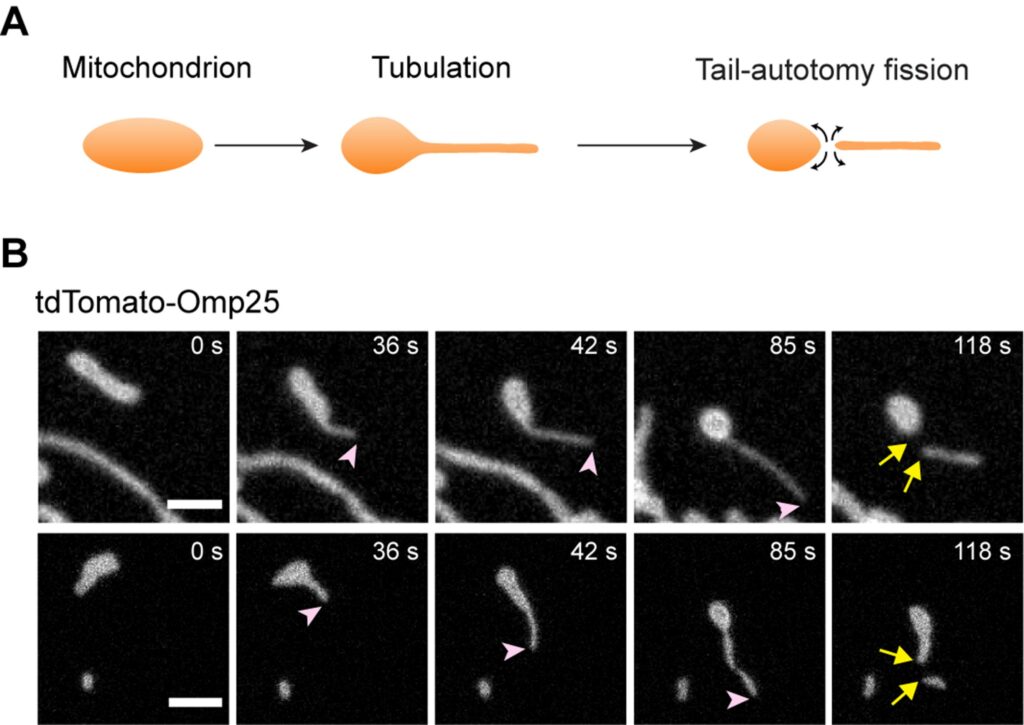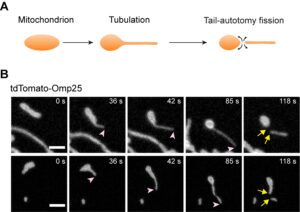CUHK
News Centre
CUHK research: Mitochondria shed their tails like lizards to maintain health
- When mitochondria, cells’ energy generators, sense a force, they can pinch off a piece of themselves in a process that’s akin to a lizard shedding its tail.
- This phenomenon, termed “tail-autotomy fission”, allows mitochondria to remove damaged parts and sustain their health.
Mitochondria, a type of specialised subunit within cells, act as the powerhouses, generating the energy needed for cellular activities. The Duan Lab led by Professor Liting Duan in The Chinese University of Hong Kong (CUHK)’s Department of Biomedical Engineering has made a groundbreaking discovery, revealing that mitochondria can break off parts of themselves, mimicking the “self-amputation” behaviour of lizards, and this “tail-autotomy fission” is force-induced. This research was published in the peer-reviewed journal The Proceedings of the National Academy of Sciences (PNAS).
What is tail-autotomy fission?
Mitochondria are highly dynamic structures within cells that constantly undergo fission and fusion. Mitochondrial fission, similar to cell division, is the process by which one mitochondrion divides into two daughter mitochondria; the opposite process, in which two mitochondria join together to form one mitochondrion, is referred to as mitochondrial fusion. The finely tuned balance of mitochondrial fission and fusion is critical to the maintenance of cell function and health.
Contrary to the previous belief that mitochondrial fission occurs randomly, Professor Duan Liting’s team identified a new type of mitochondrial fission with distinct morphological features from canonical fission similar to autotomy. Autotomy is the behaviour by which animals such as lizards, when caught by the tail, shed it in order to escape from predators. The autotomy-like mitochondrial fission that the team denoted tail-autotomy fission features two consecutive naturally occurring steps. First, a thin, tail-like tubule extends out from the bulkier main body. Next, the tubule gets disconnected, resembling the autotomy of a tail.
How does tail-autotomy fission occur?
Professor Duan’s research team also found that tail-autotomy fission is caused by force. They developed a technique based on the principles of optogenetics, a method that uses light to control cells. By delivering light to mitochondria, the researchers were able to apply physical force to them without the need to actually touch and possibly damage the delicate structures within the cells. The researchers observed that mitochondria can sense the force and respond to it by undergoing tail-autotomy fission.
The function of tail-autotomy fission
Following tail-autotomy fission, the mitochondrion is divided into a main body and a small tubule. The mitochondria matrix is kept in the former, while the latter carries away the unwanted materials from the outer surface of mitochondria and is degraded via mitophagy, a mechanism of removing damaged mitochondria inside cells. Hence, tail-autotomy is a self-preservation strategy for mitochondria, allowing them to precisely discard unwanted parts of themselves and maintain their health.
Professor Duan concluded, “Our research offers new perspectives on the diverse ways mitochondria can maintain their health and functionality, and how they respond to physical forces to regulate their own structure. Understanding this could help us unravel the complexities of cellular health and the mechanisms underlying various diseases.”
The full text of the research paper can be found at: https://www.pnas.org/doi/10.1073/pnas.2217019121







